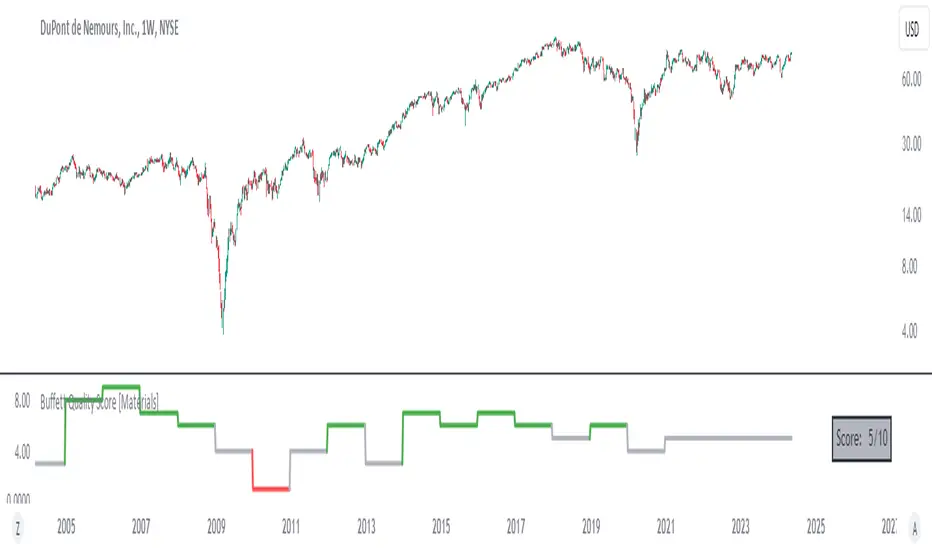PROTECTED SOURCE SCRIPT
Buffett Quality Score [Materials]

The Buffett Quality Score tailored for the Materials sector aims to assess the financial strength and quality of companies within this industry. Each selected financial ratio is strategically chosen to align with the unique characteristics and challenges prevalent in the Materials sector.
Selected Financial Ratios and Criteria:
1. Asset Turnover > 0.8
2. Current Ratio > 1.5
3. Debt to Equity Ratio < 1.0
4. Gross Margin > 25.0%
5. EBITDA Margin > 15.0%
6. Interest Coverage Ratio > 3.0
7. EPS One-Year Growth > 5.0%
8. Revenue One-Year Growth > 5.0%
9. Return on Assets (ROA) > 5.0%
10. Return on Equity (ROE) > 10.0%
Score Interpretation:
Development and Context:
The selection and weighting of these specific financial metrics underwent meticulous research and consideration to ensure relevance and applicability within the Materials sector. This scoring framework aims to provide actionable insights for stakeholders navigating investment decisions and evaluating company performance in the Materials industry.
Disclaimer: This information serves as an educational resource on financial evaluation methodology tailored for the Materials sector. It does not constitute financial advice or a guarantee of future performance. Consult qualified professionals for personalized financial guidance based on your specific circumstances and investment objectives.
Selected Financial Ratios and Criteria:
1. Asset Turnover > 0.8
- Relevance: In the Materials sector, efficient asset utilization is crucial for productivity and profitability. A high Asset Turnover (>0.8) indicates effective management of resources and operational efficiency.
2. Current Ratio > 1.5
- Relevance: Materials companies often require adequate liquidity to manage inventory and operational expenses. A Current Ratio > 1.5 ensures sufficient short-term liquidity to support ongoing operations and investments.
3. Debt to Equity Ratio < 1.0
- Relevance: Given the capital-intensive nature of Materials projects, maintaining a low Debt to Equity Ratio (<1.0) signifies prudent financial management with reduced reliance on debt financing, essential for stability amid industry fluctuations.
4. Gross Margin > 25.0%
- Relevance: Materials companies deal with varying production costs and market pricing. A Gross Margin exceeding 25.0% reflects effective cost management and pricing strategies, critical for profitability in a competitive market.
5. EBITDA Margin > 15.0%
- Relevance: Strong EBITDA margins (>15.0%) indicate robust operational performance and profitability, essential for sustaining growth and weathering industry-specific challenges.
6. Interest Coverage Ratio > 3.0
- Relevance: The Materials sector is subject to market cyclicality and commodity price fluctuations. An Interest Coverage Ratio > 3.0 ensures the company's ability to service debt obligations, safeguarding against financial risks.
7. EPS One-Year Growth > 5.0%
- Relevance: EPS growth > 5.0% demonstrates the company's ability to generate sustainable earnings amidst industry dynamics, reflecting positive investor sentiment and potential future prospects.
8. Revenue One-Year Growth > 5.0%
- Relevance: Materials companies require consistent revenue growth (>5.0%) to support expansion initiatives and capitalize on market opportunities, indicative of operational resilience and adaptability.
9. Return on Assets (ROA) > 5.0%
- Relevance: ROA > 5.0% showcases efficient asset utilization and profitability, essential metrics for evaluating performance and competitive positioning within the Materials industry.
10. Return on Equity (ROE) > 10.0%
- Relevance: ROE > 10.0% reflects effective capital deployment and shareholder value creation, crucial for sustaining long-term growth and investor confidence in Materials sector investments.
Score Interpretation:
- 0-4 Points: Signals potential weaknesses across critical financial aspects, requiring in-depth analysis and risk assessment.
- 5 Points: Represents average performance based on sector-specific criteria.
- 6-10 Points: Indicates strong financial health and quality, demonstrating robustness and resilience within the demanding Materials industry landscape.
Development and Context:
The selection and weighting of these specific financial metrics underwent meticulous research and consideration to ensure relevance and applicability within the Materials sector. This scoring framework aims to provide actionable insights for stakeholders navigating investment decisions and evaluating company performance in the Materials industry.
Disclaimer: This information serves as an educational resource on financial evaluation methodology tailored for the Materials sector. It does not constitute financial advice or a guarantee of future performance. Consult qualified professionals for personalized financial guidance based on your specific circumstances and investment objectives.
Geschütztes Skript
Dieses Script ist als Closed-Source veröffentlicht. Sie können es kostenlos und ohne Einschränkungen verwenden – erfahren Sie hier mehr.
Plan the trade ⚡ Trade the plan
Haftungsausschluss
Die Informationen und Veröffentlichungen sind nicht als Finanz-, Anlage-, Handels- oder andere Arten von Ratschlägen oder Empfehlungen gedacht, die von TradingView bereitgestellt oder gebilligt werden, und stellen diese nicht dar. Lesen Sie mehr in den Nutzungsbedingungen.
Geschütztes Skript
Dieses Script ist als Closed-Source veröffentlicht. Sie können es kostenlos und ohne Einschränkungen verwenden – erfahren Sie hier mehr.
Plan the trade ⚡ Trade the plan
Haftungsausschluss
Die Informationen und Veröffentlichungen sind nicht als Finanz-, Anlage-, Handels- oder andere Arten von Ratschlägen oder Empfehlungen gedacht, die von TradingView bereitgestellt oder gebilligt werden, und stellen diese nicht dar. Lesen Sie mehr in den Nutzungsbedingungen.